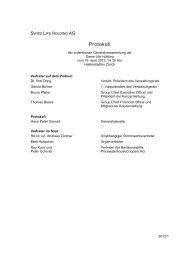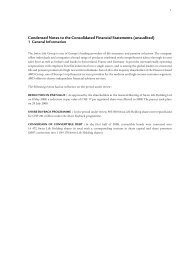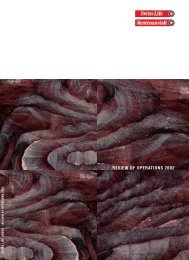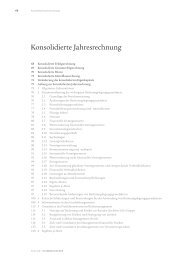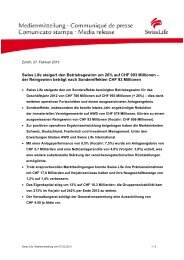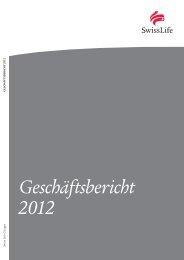Annual Report 2012 - Swiss Life
Annual Report 2012 - Swiss Life
Annual Report 2012 - Swiss Life
Create successful ePaper yourself
Turn your PDF publications into a flip-book with our unique Google optimized e-Paper software.
138 Consolidated Financial Statements<br />
The interest rates used in actuarial formulae to determine the present value of future benefits and<br />
contributions caused by an insurance contract are called technical interest rates. The technical interest<br />
rates have to be approved by the regulator. In certain countries, the insurance liabilities are based on<br />
the technical interest rates.<br />
Impairment of goodwill<br />
Goodwill is tested for impairment annually (in autumn), or more frequently if events or changes in<br />
circumstances indicate that goodwill might be impaired. The recoverable amounts of the business<br />
relating to the goodwill have been determined based on value-in-use calculations. These calculations<br />
require the use of estimates which are set out in note 18.<br />
Defined benefit liabilities<br />
The <strong>Swiss</strong> <strong>Life</strong> Group uses certain assumptions relating to the calculation of the defined benefit liabilities.<br />
These assumptions comprise the expected return on plan assets as well as future salary increases<br />
and future pension increases which have been derived from estimates based on past experience. The<br />
expected return on the plan assets takes into consideration the investment policy relating to the<br />
assets and their projected returns.<br />
The assumptions are set out in note 24.<br />
Income taxes<br />
Deferred tax assets are recognised for unused tax-loss carryforwards and unused tax credits to the<br />
extent that realisation of the related tax benefit is probable. The assessment of the probability with<br />
regard to the realisation of the tax benefit involves assumptions based on the history of the entity and<br />
budgeted data for the future.<br />
Provisions<br />
The recognition of provisions involves assumptions about the probability, amount and timing of an<br />
outflow of resources embodying economic benefits. A provision is recognised to the extent that an<br />
outflow of resources embodying economic benefits is probable and a reliable estimate can be made.<br />
4 Segment Information<br />
Operating segments are components of an entity about which separate financial information is available<br />
that is evaluated regularly by management (corporate executive board) in deciding how to allocate<br />
resources and in assessing performance.<br />
The accounting policies for the segments are the same as those described in the Summary of Significant<br />
Accounting Policies section. Inter-segmental services and transfers of assets and liabilities are treated<br />
as if the transactions were with third parties, i.e. at market prices applicable at the time of the transaction.<br />
Corporate costs were not allocated to the individual segments as they consist of general administrative<br />
expenses and head office expenses that relate to the <strong>Swiss</strong> <strong>Life</strong> Group as a whole.<br />
<strong>Swiss</strong> <strong>Life</strong> – <strong>Annual</strong> <strong>Report</strong> <strong>2012</strong>



